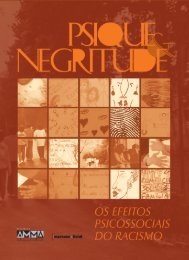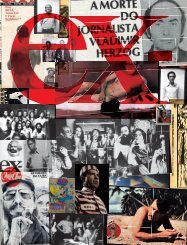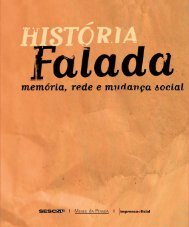CLÁSSICOS BRASILEIROS BRAZILIAN CLASSICS - Imprensa Oficial
CLÁSSICOS BRASILEIROS BRAZILIAN CLASSICS - Imprensa Oficial
CLÁSSICOS BRASILEIROS BRAZILIAN CLASSICS - Imprensa Oficial
You also want an ePaper? Increase the reach of your titles
YUMPU automatically turns print PDFs into web optimized ePapers that Google loves.
Brazilian Classics<br />
A selection of authors with works in public domain<br />
66<br />
JOÃO DO RIO<br />
(1881 – 1921)<br />
Along with Machado de Assis and Lima Barreto,<br />
Paulo Barreto, a mulatto man, just like the other<br />
two, makes up the best urban prose's trio from the<br />
beginning of the 20th century. This novelist, who<br />
was also a storyteller, a journalist, a playwright,<br />
a chronicler, a lecturer, and an essayist, took the<br />
blending of reporting and literary chronicles to<br />
its last consequences, innovating on the writing<br />
produced at the time. It is not false to say that<br />
the belle-époque Rio de Janeiro was indeed an<br />
invention of this man, who is the best example<br />
of the Brazilian art nouveau literature. His life<br />
and work fuses with the city, whose multiple<br />
aspects he portrayed so well. Attending from<br />
important presidential receptions to spiritualist<br />
congregations in the outskirts of the city, as<br />
well as samba parties in the slums of Rio de<br />
Janeiro, he mingled with the crowd to describe<br />
the routine of the downtrodden people of the<br />
time. In addition to the color of his skin, already<br />
a reason for discrimination, his homosexuality<br />
defied the standards. But he did not become<br />
popular as Paulo Barreto, but rather as João do<br />
Rio, one of his many pen names.<br />
Review<br />
Main works<br />
Excerpt<br />
The enchanted soul of the streets<br />
We were at Núncio Street. My good friend took<br />
me into a bar on the corner with S. Pedro Street.<br />
The wall of the house soon caught my eyes,<br />
forgetting about the noise, the voices, the din<br />
of people in and out of the place. I was before<br />
a great commemorative mural painting. The<br />
painter, surely excited by the outburst of pride<br />
that took us all over when we saw the Central<br />
Avenue, decided to immortalize it by painting it<br />
on the wall, from Ouvidor Street to Prainha. The<br />
conception was grandiose, the subject was vast -<br />
the advent of our progress would be motionless<br />
there forever, as long as Núncio Street remains.<br />
I noticed that Casa Colombo and Primeiro<br />
Barateiro appeared in a neat foreground while<br />
the buildings would little by little, in an airblowing,<br />
fade hastily away.<br />
Master of the lyric disorder<br />
"He was a master of the chronicle, unrivaledly mastering a confusing and illusory, hybrid and fluttering style; a Byzantine<br />
mosaic he turned into sheer work of art, either by the insolence of satire, or by the beautiful Iyric disorder of certain<br />
descriptions ".<br />
(Agrippino Grieco, Evolução da prosa brasileira)<br />
A perfect uniqueness<br />
'One of the most original, independent, brilliant, prolific, and pioneering figures our literature has ever produced."<br />
(João Carlos Rodrigues, João do Rio: uma biografia)<br />
As religiões no Rio (1904); A alma encantadora das ruas (1908); Cinematographo (1909); Dentro da noite (1910); A<br />
profissão de Jacques Pedreira (1911); Psicologia urbana (1911); Vida vertiginosa (1911); Memórias de um rato de hotel<br />
(1912); Pall Mall (1917); A mulher e os espelhos (1919); Rosário da ilusão (1921); Celebridades, desejo (1932).









